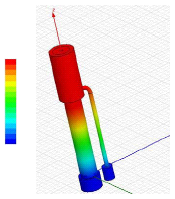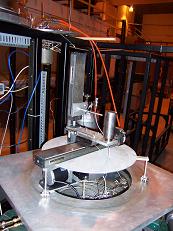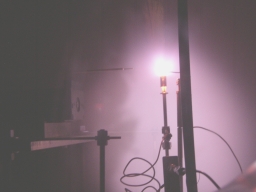Phone: (970)491-8564
Fax: (970)491-8671
Email: john.d.williams@colostate.edu
Plasma Current Sensor
Fall 2007 – Spring 2008
Advisors: Binyamin Rubin, John Williams
Team Members: Ryan Beckett, Nicholas Denning, Chris Dykema, Jordan Fisk, Brady Kirkwood, Nicholas Riedel, Jonathan Wolf

The goals of the 2007-2008 senior design project included designing and building a Hall effect thruster, designing and building a thrust stand to measure thrust output, and correlating thrust measurements with thrust levels determined using magnetic field data collected during thruster operation. The calculation of thrust and the azimuthal Hall current structure using magnetic field data is an inverse problem. Non-contact magnetic field sensors can be integrated into a Hall thruster to provide real-time flight diagnostics, not only identifying accelerating channel processes but also thruster malfunction mechanisms. These sensor capabilities are under ongoing investigation at CSU.
FAST Starting Hollow Cathode Test Pallet
Fall 2006 – Spring 2007
Advisors: Binyamin Rubin, John Williams
Team Members: Meghan Capra, Matthew Larson, Daniel Strawn, Steen Vecchi, Jeffery Wyant

The 2006-2007 senior design team designed and fabricated a fast starting hollow cathode assembly for use on a sounding rocket mission, operated by the Japanese Aerospace Exploration Agency (JAXA), set to launch in 2009.
The mission will test an electromagnetic tether, a device that has the potential to either accelerate or brake an orbiting spacecraft. The tether, a long conductor, is deployed so that it cuts across the Earth’s magnetic field lines, generating an electric field between the far end and the opposite end attached to the spacecraft. In the ionosphere, electrons are readily collected at the far (bare) end, which naturally biases positive of the space plasma. A hollow cathode can be used on the spacecraft end to emit electrons for instance, creating a current. Current in the conductor interacts with the magnetic field to either accelerate or decelerate the spacecraft.
For the sounding rocket mission, the fast starting hollow cathode will act as a plasma bridge, providing a reference ground for the rocket so that biases can be applied to the tether. The sounding rocket flight is estimated to last roughly six minutes, thus the hollow cathode will start in under two minutes to leave sufficient time for experimental testing.


MAPPS: Multi Axis Plasma Profiler System
Fall 2005 – Spring 2006
Advisors: Casey C. Farnell, John Williams
Team Members: Robert Millot, Molly Schmidt, Dustin Warner, Kyle Siler-Evans

Working with Veeco Instruments, an automated three dimensional probe positioning device was created to obtain measurements of ion beam plume properties, such as current density, downstream of ion sources. The 3-D map of current density found using the device can be used to accurately predict the current density profile that would fall on a target placed in an arbitrary location within the plasma plume. This in turn allows for better predictions and understanding of material deposition processes, which the ion sources are often used for.


RAPID: Rapidly Actuating Probe for Ion Diagnostics
Fall 2004 – Spring 2005
Advisors: Russell H. Martin, John Williams
Team Members: Seth Bell, Brad Maraccini, Marcus Jones, Jim Perkins, Dennis Schmitt

A diagnostic probe system was developed in collaboration with the Air Force Research Laboratory to study the high intensity plasma region near hollow cathodes. Plasma properties are studied by taking Langmuir probe traces as the probe travels through the plasma at high speed. A Langmuir probe trace can give information about electron temperature and velocity, plasma density, floating and plasma potential, and electron and ion saturation. Two systems were developed: a prototype ball screw system and a final design linear motor system.


Ion Propulsion Probe Positioning System
Fall 2003 – Spring 2004
Advisors: Horizon Gitano-Briggs, John Williams
Team Members: Ehren Ehmann, Paul Shoemaker, Timothy Westhoff, Trinity Troutt

An actuator system was developed to autonomously position and record E x B probe measurements downstream of an ion source. This facilitates measurements of thrust factor, beam divergence, and charge state distributions. Three systems were designed: PROTO-1 for use at CSU, a Boeing System for their facility in Torrance, California, and a final system for Marshall Space Flight Center in Huntsville, Alabama.
Solar Wind Simulator
Fall 2002 – Spring 2003
Advisors: John Williams, Paul Wilbur
Team Members: Michael Gardner, Justin Bult, Derek Reding, Colin Olson

An ion source was designed that was able to simulate the Sun’s solar wind, the stream of high energy charged particles that emanate from the corona, the Sun’s outer atmosphere. The solar wind travels between 300 and 800 km/s, and an ion source was one way to simulate this velocity. The simulator was to be used with the Mini Magnetospheric Plasma Propulsion (M2P2) device at Marshall Space Flight Center. This device expands a magnetic bubble around a spacecraft and catches the solar wind for propulsion.



